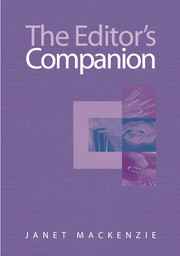Book contents
- Frontmatter
- Contents
- List of illustrations
- Preface
- 1 The editor in context
- 2 The publishing process
- 3 Management and liaison
- 4 Substance and structure
- 5 Language
- 6 Illustrations and tables
- 7 Completeness and consistency
- 8 Proofs
- 9 Editing methods
- 10 Working with documents and files
- 11 Freelance editing
- Appendix: Australian Standards for Editing Practice
- Notes
- Select bibliography
- Index
3 - Management and liaison
Published online by Cambridge University Press: 05 June 2012
- Frontmatter
- Contents
- List of illustrations
- Preface
- 1 The editor in context
- 2 The publishing process
- 3 Management and liaison
- 4 Substance and structure
- 5 Language
- 6 Illustrations and tables
- 7 Completeness and consistency
- 8 Proofs
- 9 Editing methods
- 10 Working with documents and files
- 11 Freelance editing
- Appendix: Australian Standards for Editing Practice
- Notes
- Select bibliography
- Index
Summary
At the risk of imitating the podiatry textbook which claimed that the foot extends to the armpit, I see the editor as the pivotal figure in the production process, at the centre of a triangle. The points of the triangle are:
Author: It's my book!
Publisher: I'm paying the bills!
Reader: Don't forget me! I'm the purpose of the whole exercise!
For the author you are an assistant; for the publisher you are a quality controller; for the reader you are an advocate. So you're always subject to a three-way stretch, balancing competing demands.
Liaison and negotiation
The aim in liaison is to work out what everyone needs to know and to tell them at the appropriate time. The editor maintains the flow of information between author, publisher, designer and typesetter, but don't flood people with detail they don't need.
Before you begin editing, find out whether the publisher or commissioning editor has informed the author of the schedule and told her what she is expected to do in the way of approving changes, obtaining illustrations and permissions, providing material for publicity, preparing the index and so on, and especially the technical requirements for these tasks. You may have to brief the author yourself.
During the project, keep the publisher informed of progress and co-ordinate your approaches to the author so she doesn't receive contradictory instructions. If you haven't heard from the author for a while, ask the publisher about the state of play.
- Type
- Chapter
- Information
- The Editor's Companion , pp. 38 - 57Publisher: Cambridge University PressPrint publication year: 2004



